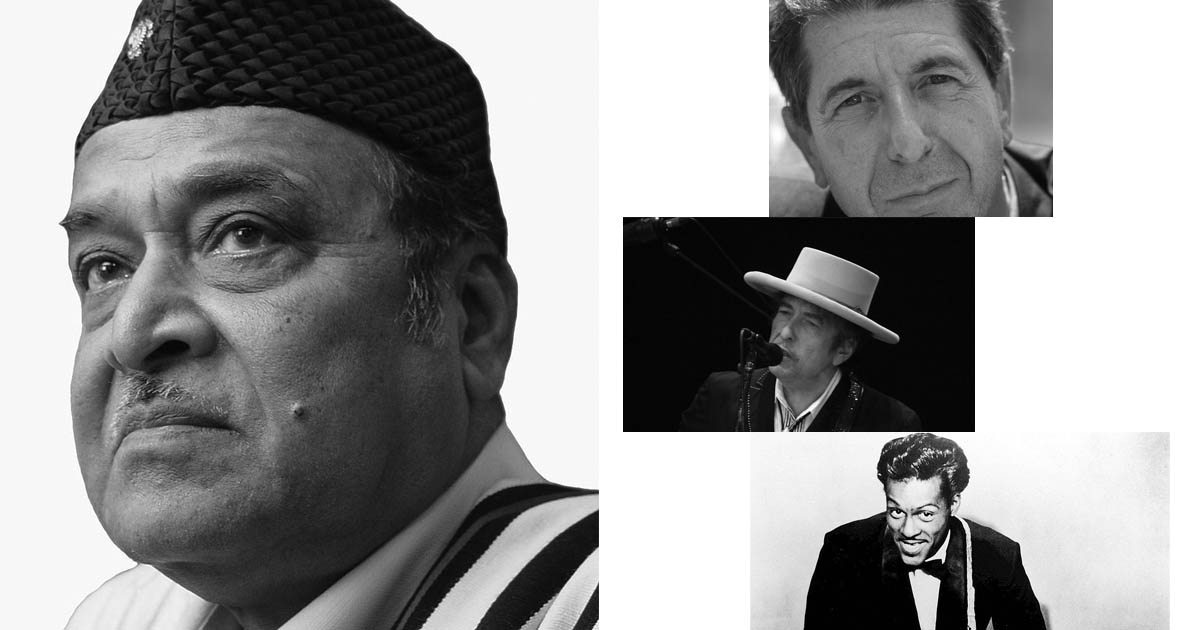Historically, Present Perfect
Eleven years after he died, Bhupen Hazarika holds steady among the world's greats such as Leonard Cohen, Bob Dylan and Chuck Berry, his work slowly winning the battle against time

One wonders what the secret to the perfect song is. Perfect words, emotionally? (Bhupenda’s ‘Mor morome morom bisari jai…’). Striking philosophical visuals in melody? (Leonard Cohen’s ‘Anthem’: ‘There is a crack, a crack in everything… That’s how the light gets in… ). Uncontrollable human pathos? (Bob Dylan’s ‘Tambourine Man’: My weariness amazes me, I’m branded on my feet, I have no one to meet, And the ancient empty street’s too dead for dreaming…). Musically canned lust and everything basic instinct? (Dave Bartholomew’s and the father of rock n roll Chuck Berry’s cover of his ‘My Ding a Ling’ that was to become Chuck’s only Billboard No 1? (My ding-a-ling, my ding-a-ling, I want you to play with my ding-a-ling!) The year was 1972, and Bartholomew and then Chuck in the midst of their musical mirth went ahead and sang for those ignored, marginalised, exploited and tormented and often terrorised: ‘I heard two girls over here singing in harmony, that’s all right, honey. This is a free country, live like you wanna live, baby!’ LQBTQ rights became legal in the US after a Supreme Court ruling only in 2003 but Bartholomew and Chuck were the soothsayers–and guardian angels in a way–in 1972.
LGBTQ rights isn’t something Bhupenda perhaps sang about. But he did sing about the love and wedding of Juboti Onamika Goswami and Jubak Proxanto Dax at Kamakhya, the two of different castes (‘high’ and ‘scheduled’ as we have labelled our people). The couple came to him for his blessings, he says, and he writes:
‘Moha xunyot upogroho rakhi
Eya gono xongjog korowar jug
Aru anobik xoktik dabonor pora ani
Manobor xewat logowar jug
Eiya Proxanto aru Onamikar jati kul homagnir jug
Eiya jonar jog, eiya bujar jug
Eiya jet jog, anowik jug
Eiya ximar poridhi bhongar jog…
‘Monor pothar bohol kori
Premor roxere jipal kori
Eya manobota kothiya xisar jug…
Loosly translated that would mean:
This is the time to put satellites in space and let the masses communicate, the time to bring atomic power from the hands of the beast to be used in the service of mankind, the age of Proxanto and Onamika, the age when caste is burned at the yagna of the couple’s wedding. This is the age of learning, of understanding, of jet planes, of the atomic, this is the age of breaking the limits of boundaries…broadening the fields of one’s mind and watering it with love, this is the age of planting saplings of humanity. That song was released in 1991, perhaps earlier, all encompassing and still so true.
And it wasn’t like Bhupenda was always the social revolutionary who sang only about social unrest and discontent. He had so much to document, so much to save. Like his guru Kolaguru Bishnu Proxad Rabha in Era Bator Xur, immortalising one of Oxom’s greatest’s acting skills in that film… Like bringing to mainstream Oxomiya music Goalpariya Lokogeet in the same film.
Love too would have to be encapsulated–direct, no holds barred, saying it like it is: Kije tomar xongo priya, kije tomar xongo, tomar ongo jolonto jui, moi je potongo… These are verses that perhaps defy even an attempted transcreation, just in the way ‘Notun, nimati, niyoyore nixa, jion jilika jonakore xikha, aru tumi nisei sinaki…’ would lose not just its internal rhyme but also the warm love that snuggles within it, should one touch it with a language other than Bhupenda’s.
Of his song ‘Bimurto mor nixatijen…’ that now gains immense popularity, with cover versions, Bhupenda had once said that it was an ‘oslil’ (obscene) song which he had put in verse so well. Politician and poet Dev Kant Barooah warned Bhupenda that he would offend Assam’s womenfolk with that composition. But that was not to be. ‘Kamonare tej ronga, ajir gobhir gorbhote, Nirob morom barixar bohut xaun bhador…’ it goes…With time, the song has gone from Bhupenda’s self-confessed ‘oslil’ to now being “sensuous”.
That’s a 1988 song in evolution, as a society changes. As Bhupenda says in ‘Juboti Onamika Goswami…’ ‘Unobingxo xotikar dhyan-dharona, bingxo xotikat xobha nepai, Ekobingxo xotika ahibole tenei doxo khoje nai… (Thoughts of the Nineteenth century don’t fit the Twentieth, And we have only a few steps to go to get to the Twenty-first…)
And then there is the sublime: Bhupenda’s Kohua bon mor oxanto mon… which he writes for a film without knowing what the final visual would be. As much as people wish to make Bhupoenda out to be a sentimenal poet, based on his “Moi jetiya ei jobonor maya eri gusi jaam”, that song would have been a one-off. His love for life was greater: Tumar obihone seep jori lom buli jodi tumi bhaabisa, Bhul korisa xonjoni mor, Aleek xopon dekhisa… (Xoixowote dhemalite)
Every song of Bhupenda does not have to be an anthem. Only, that his anthems have to hold, and they do. And so one has Bistirna Parore from Bhupenda, Hallelujah from Leonard Cohen and Blowing in the wind from Bob Dylan… And yes that classic Rock and Roll from Chuck Berry…
For those who wonder about the headline to this piece sounding funny (and it does sound convoluted), would it now make sense? That’s Bhupenda, contextually always real, and historically in the present. Bhupenda is a difficult man to headline…
(Pictures Clockwise from left: Bhupen Hazarika, Leonard Cohen, Bob Dylan, Chuck Berry)
(Bhupen Hazarika Photo by Utpal Barua, courtesy Wikipedia, Leonard Cohen photo courtesy Wikipedia, by Gorupdebesanez, Bob Dylan photo courtesy Wikipedia by Alberto Cabello, Chuck Berry photo courtesy Wikipedia by Universal Attractions)


